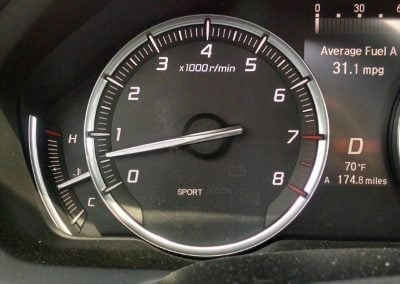What causes a high RPM while idling?

In most cars, idle speed should be under 1000 RPM when the engine is warm.
Idle speed is a term that is used to describe the revolutions of the engine per minute (or RPM) while your car is sitting still with the engine running. High idle speeds can be a sign of a damaged or malfunctioning engine component. High RPMs can be unsafe when idling. This is because they can lead to the car suddenly jerking forward when the brake is released. It can also lead to excess fuel consumption and cost. For this reason, we recommend getting your car inspected by a professional mechanic if you are experiencing higher than normal idle speeds.
Below are some of the most common causes of high RPMs while idling:
- Vacuum leak – A vacuum leak occurs when air enters the engine outside of the normal intake system. This additional air disrupts the air-fuel mixture, leading to a higher idle speed. Vacuum leaks can be caused by cracked or disconnected vacuum hoses, a faulty intake manifold gasket, or a malfunctioning idle control valve.
- Faulty idle air control valve – The idle air control valve regulates the amount of air entering the engine when the throttle is closed. If the idle air control valve becomes dirty or malfunctions, it may allow too much air into the engine, resulting in a higher idle speed.
- Faulty throttle position sensor (TPS) – The throttle position sensor monitors the position of the throttle plate in the throttle body. A malfunctioning TPS can send incorrect signals to the engine control unit (ECU), causing the idle speed to increase.
- Faulty or dirty mass airflow sensor (MAF) – The mass airflow sensor measures the amount of air entering the engine and communicates this information to the ECU. If the MAF becomes dirty or malfunctions, it can provide incorrect readings, resulting in an elevated idle speed.
- Dirty air intake – When contaminants enter your air intake system, they can affect how much air enters your engine and cause problems with the throttle system. This can lead to rougher idling.
- Blown fuse – The fuse that controls the idle control system can fail. This results in the valve being unable to regulate idle speed.
- Faulty EGR valve – if the EGR valve gets stuck in the wrong position or develops a vacuum leak, then sometimes this can cause high engine RPM.
Other symptoms of high idle speed:
- Engine jerks forward – When there are high RPMs while idling, it may cause automatic cars to suddenly move forward when the driver switches to “drive” or the brake is released. This can lead to unpredictable movements which can cause collisions or accidents.
- Check engine light – A common cause of increased idle RPMs is an incorrect air/fuel ratio. When the air/fuel ratio is incorrect, the check engine light will usually appear on your dashboard.
- Loud engine – High RPMs will often lead to a louder engine when idling. This can also cause noticeable vibrations that can affect the comfort of your car.
High Idle Speed – Diagnostics and Inspection in Hamilton
It’s important to address a high idle speed promptly as it can impact fuel efficiency, engine performance, and vehicle drivability. If you experience a consistently high RPM while idling, it is recommended to have your vehicle inspected by a qualified mechanic who can diagnose the specific cause and perform any necessary repairs or component replacements.
At Grimmer Motors, our team of talented mechanics can quickly and accurately diagnose problems related to high idle speed. We can then provide expert services and replacements to get your car idling healthily again.
For engine idle speed servicing and diagnostics in Hamilton, contact Grimmer Motors today!

